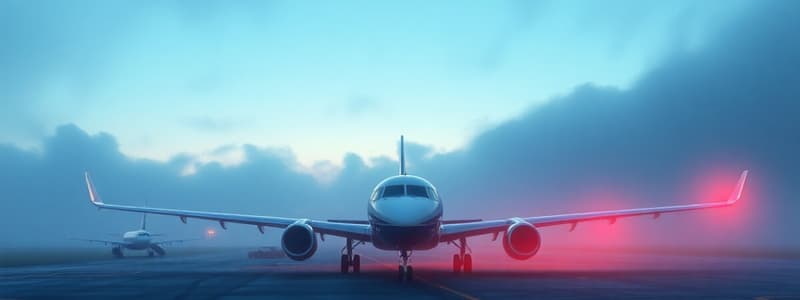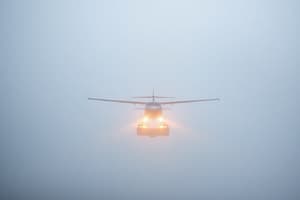Podcast
Questions and Answers
What RVR condition generally necessitates low visibility procedures at aerodromes authorized for CAT ll/lll operations?
What RVR condition generally necessitates low visibility procedures at aerodromes authorized for CAT ll/lll operations?
- RVR below 300 metres
- RVR below 500 metres
- RVR below 400 metres and/or the cloud base falls below 200feet. (correct)
- RVR below 200 metres
What is the minimum cloud base height that triggers low visibility operations?
What is the minimum cloud base height that triggers low visibility operations?
- 250 feet
- 200 feet (correct)
- 150 feet
- 300 feet
Who is responsible for establishing airfield operating minima?
Who is responsible for establishing airfield operating minima?
- Airport authority (correct)
- Aircraft operators
- International aviation organizations
- National aviation authorities
What must be provided for an instrument approach and landing to be conducted in less than 800m visibility?
What must be provided for an instrument approach and landing to be conducted in less than 800m visibility?
What is required for crews to maintain currency in CAT II/III operations?
What is required for crews to maintain currency in CAT II/III operations?
What should be done if failures are announced before the approach ban point?
What should be done if failures are announced before the approach ban point?
What should be assessed before attempting another approach after a failure announcement?
What should be assessed before attempting another approach after a failure announcement?
For CAT II and CAT III operations, what combination of deficiencies is not permitted?
For CAT II and CAT III operations, what combination of deficiencies is not permitted?
If there is a failure other than ILS, what aspect is affected?
If there is a failure other than ILS, what aspect is affected?
What must be obtained before attempting a CAT II/III approach?
What must be obtained before attempting a CAT II/III approach?
What is the RVR condition for LVTO take-off?
What is the RVR condition for LVTO take-off?
What is a required action during flight preparation for low visibility conditions?
What is a required action during flight preparation for low visibility conditions?
Which conditions necessitate the requirement of a take-off alternate airport?
Which conditions necessitate the requirement of a take-off alternate airport?
What is a recommendation during low visibility operations?
What is a recommendation during low visibility operations?
Which thrust setting should be used for take-off according to the procedures?
Which thrust setting should be used for take-off according to the procedures?
What should be included in the Low Visibility Take-off Briefing?
What should be included in the Low Visibility Take-off Briefing?
When is it approved for automatic rollout during CAT II/III approaches?
When is it approved for automatic rollout during CAT II/III approaches?
What must the Pilot in Command do at decision height (DH) during a low visibility approach?
What must the Pilot in Command do at decision height (DH) during a low visibility approach?
Flashcards
Low Visibility Operations (LVO)
Low Visibility Operations (LVO)
Low visibility procedures are implemented when visibility falls below a certain threshold. This can be in terms of runway visual range (RVR) or cloud base height.
Airfield Operating Minima
Airfield Operating Minima
Minimum visibility conditions for landing and takeoff, determined by the airport authority and published on approach charts.
Operator's Minima
Operator's Minima
The lowest visibility conditions that an airline is allowed to operate in, following approval from their regulatory authority.
Letter of Approval
Letter of Approval
Signup and view all the flashcards
Visibility Limit
Visibility Limit
Signup and view all the flashcards
Crew Currency for CAT II/III Approaches
Crew Currency for CAT II/III Approaches
Signup and view all the flashcards
Who certifies crew currency?
Who certifies crew currency?
Signup and view all the flashcards
What are CAT II/III approaches?
What are CAT II/III approaches?
Signup and view all the flashcards
What is recurrent training?
What is recurrent training?
Signup and view all the flashcards
Why use simulators for CAT II/III training?
Why use simulators for CAT II/III training?
Signup and view all the flashcards
What happens if a runway light fails during an approach?
What happens if a runway light fails during an approach?
Signup and view all the flashcards
What are the rules for multiple runway light failures?
What are the rules for multiple runway light failures?
Signup and view all the flashcards
Are combined failures of runway lights and RVR equipment allowed in CAT II/III operations?
Are combined failures of runway lights and RVR equipment allowed in CAT II/III operations?
Signup and view all the flashcards
How do non-ILS failures affect RVR and DH?
How do non-ILS failures affect RVR and DH?
Signup and view all the flashcards
What must a pilot do after assessing the impact of an equipment failure?
What must a pilot do after assessing the impact of an equipment failure?
Signup and view all the flashcards
Who performs low visibility take-off and landings?
Who performs low visibility take-off and landings?
Signup and view all the flashcards
What is required before a CAT II/III approach?
What is required before a CAT II/III approach?
Signup and view all the flashcards
What does the pilot prepare for a low visibility flight?
What does the pilot prepare for a low visibility flight?
Signup and view all the flashcards
What defines a Low Visibility Take-Off (LVTO)?
What defines a Low Visibility Take-Off (LVTO)?
Signup and view all the flashcards
What's required for a low visibility takeoff in challenging weather?
What's required for a low visibility takeoff in challenging weather?
Signup and view all the flashcards
What are Low Visibility Procedures?
What are Low Visibility Procedures?
Signup and view all the flashcards
What's the first step before a CAT II/III approach?
What's the first step before a CAT II/III approach?
Signup and view all the flashcards
What is the Decision Height (DH) in low visibility operations?
What is the Decision Height (DH) in low visibility operations?
Signup and view all the flashcards
What is the Take-Off Go-Around procedure?
What is the Take-Off Go-Around procedure?
Signup and view all the flashcards
Why is TOGA thrust used for take-off?
Why is TOGA thrust used for take-off?
Signup and view all the flashcards
Study Notes
All Weather Operations (AWO)
- Low visibility procedures apply at aerodromes authorized for CAT II/III operations when RVR is below 400 meters and/or cloud base is below 200 feet.
- SriLankan Airlines' low visibility minima are approved by the CAASL and published in the Flight Operations Manual (FOM).
- Low visibility operations (LVO) necessitate specific crew qualifications, procedures, aircraft equipment, and state approval.
- Crew competency is certified by the flight operations department. Crews must maintain currency by completing a minimum of two CAT II/III simulator approaches during recurrent training/check.
- Failures in ground equipment before the approach ban point lead to approach discontinuation. Assessment of failure impact is mandatory before attempting a subsequent approach.
- After the ban point, the commander may continue the approach if failures occur.
- Multiple runway light failures (beyond those specified) are unacceptable.
- Runway/approach light deficiencies are assessed separately.
- CAT II/III operations, combined runway light and RVR assessment equipment failures are forbidden.
- ILS-unrelated failures only affect RVR; DH (Decision Height) isn't impacted.
- ATC clearance is required for CAT II/III approaches. CAT II/III approaches must not be attempted without clearance. Announcements are made on ATIS when the airfield has CAT II/III operations in process.
- Flight crew shall ensure the aircraft does not pass the CAT II/III holding point until clearance is received to enter the runway.
- Low Visibility Procedures and task sharing are detailed in the FCOM PRO-NOR-SOP and FCTM-PR-NP-SOP.
- Pre-flight planning for low visibility operations should include reviewing NOTAMS for CAT II/III requirements, confirming runway and approach lighting, radio navigation aid availability, and RVR equipment availability.
Airfield Operating Minima
- Airfield operating minima are established by airport authorities and published on approach charts.
- Each state approves SriLankan Airlines' requests for specific minima, issuing a letter of approval.
- Lido publishes approach charts based on the approved category and minima.
- Instrument approaches and landings are not permitted in less than 800 meters visibility unless RVR data is available.
- Operator's minima are the lowest allowed minima, approved by the regulatory authority.
Low Visibility Take-off (LVTO)
- Take-off with RVR less than 400 meters is considered LVTO.
- Maximum RVR for takeoff is largely independent of aircraft type and equipment, except in very low RVR conditions.
- When weather conditions are below CAT I minimums, a takeoff alternate within one hour at one engine inoperative speed is normally required (refer to 10.1.4).
- Performing a flight control check when the aircraft is stationary is recommended.
- Intersection takeoff is not recommended during LVO.
- The Pilot in Command (PIC) will perform the takeoff and landings in low visibility conditions, including practice autolands in CAT I conditions.
- Landing Lights and Strobe Lights shall be switched OFF for Take-off.
- TOGA thrust shall be used for Take-off.
- The “Low Visibility Take-off Briefing” shall be completed after performing the “Take-off Briefing” and shall include the items in QRH-ALO-LVO as a minimum.
Briefings
- In addition to the normal approach briefing the items in QRH-ALO-LVO shall be included as a minimum for CAT II/III Approach Briefing.
- Before starting the approach: Verify Low Visibility Procedures in force (ATIS or ATC). Flight Crew procedures shall be as per FCOM-PRO-NOR-SOP and FCTM-PR-NP-SOP. Automatic rollout performance is only approved on dry and wet runways.
Visual References
- Visual references at DH are detailed in 10.1.5. The DH is the lower limit of the decision zone during which the PIC will be assessing the visual references in limiting conditions. The PIC should be prepared for a go-around but without pre-established judgment. The PIC should make a decision according to the quality of the approach and how the visual references develop as DH is approached.
Studying That Suits You
Use AI to generate personalized quizzes and flashcards to suit your learning preferences.




